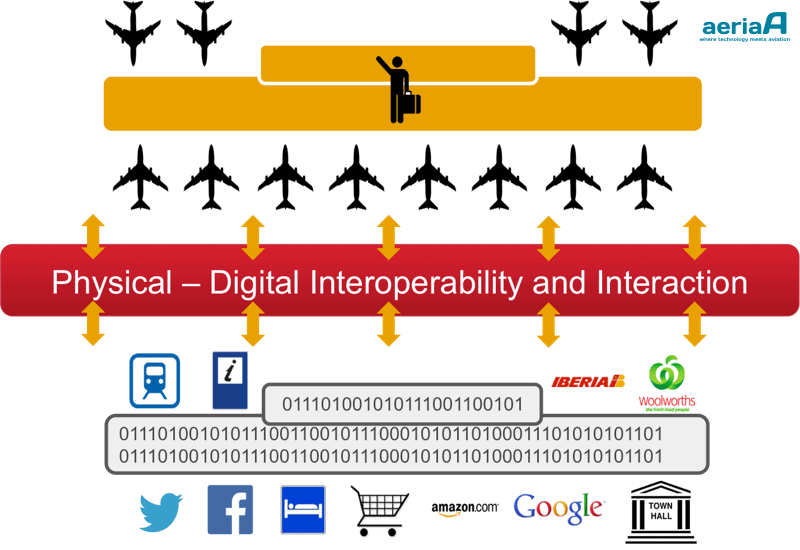Airport Passenger’s centric, new revenues paths, more cooperation between the main airport’s stakeholders (airlines, airport, ground handling, ATC…) in order to improve the punctuality and service, external 3rd party apps, new huge and modern terminals, “intermodality”, smart cities & smart airports, green airports, etc, etc. All these concepts are overflying around our minds, some of them are becoming reality, other requires innovation and willingness to invest time and money. A few weeks ago in the presentation of my book, State of-the-Art of IT technologies applied to Airports (click here see the post about it and download it), the former Madrid-Barajas Airport (MAD), Miguel Angel Oleaga, share with us three simple and deep thoughts:
“Let’s share information! If we have data from all of our partners, we can manage the airport business processes having common information for everyone and for each one.”
“The information at your fingertips. Why do not explote it from our business intelligence view? Why do not achieve a customers’ total knowledge environment? Let’s get all their potential!”
“At Airports, I believe that we are ready for offering individualized services, but, is it not some that already the technologies offer in other life’s ambiences?”
To sum up, these three quotes are referred to: Information sharing, business intelligence and situational awareness and personalization.
This post is the first of initiatives in the fields of airport data modeling, APIs, etc. This is dedicated to ACRIS introduction, but I would like to deepen into some other related thoughts about the new Digital Level.
First of all, the picture above is the title page of a presentation (it has only 8 slides), you can view it in the box that follows, click on the centered Start Prezi button, please let’s give it time to load it completely. You can view it at full screen pressing on the lower right screen icon. If you experienced any problem with the embebed presentation, you can click here to view it on Prezi’s website.
During the last 10 years airports have been modernized and the adopt state-of-art operational and managerial systems, enterprise architectures, and they’ve never stopped in the cooperation with other stakeholders as airlines, ground handling, ATC, etc. All these changes have improved the pillars of the technological capabilities of airports and made them to be prepared to the next technical leaps.
As you have seen in the slides, the nature of the human behave with the Web 2.0 – 3.0, smartphones and tablets, etc. is coming in airports and they should be catch the enormous opportunities that bring this new consumer’s behavior and the ability of connect with every single passenger through his devices. So a new Digital Level arise in front of us.
But wait a minute, where are we now? We don’t have a wide installed standard of airport language ontologies, standard APIs, etc. Every airport, or airport operator, has its main technological providers, with own IT and business strategical policies, the airport’s systems providers have great integrated products (but not all of them fits in medium or small airport’s sizes), the Regulators and Supranational Organizations are trying to ease the open standards and e-services, there are Terminals and ATM Annual Meetings that show more and more technological evolutions, the airlines innovate through all their processes, start-ups are developing amazing smartphone apps, the tourism industry digitalized every single voucher, transaction, etc, etc. And finally, we, as passengers, would like to have fast, reliable, valuable information and tools for planning and travelling in the easiest way as possible.
So how could we avoid the unmanageable situation of hundreds of services/systems/apps trying to connect n-to-n, multiplying the complexity exponentially, reducing the time-to-market, adding the huge amounts of related processes, etc.?
ACRIS:
This post is the first of a series of standardization initiatives. Let’s see a first approach leaded by ACI, the Aviation Community Recommended Information Services (ACRIS), the definition of ACRIS is hold by the ACI ACRIS workgroup (WG), created on 2009.
What is the mission of ACRIS WG?
The mission of the ACI ACRIS WG is “to deliver recommendations, requirements and technical specifications that enable airports, airlines, partners and suppliers to exchange and process data in a standardized and service oriented way”.
The main objective of this workgroup is:
- To define service descriptions for scenarios related to passengers and airports status, the collaboration between airport’s stakeholders as the A-CDM model, the services related to baggage processes…
This definition has to be made under the common IT standars, not “reinventing the wheel”.
The following ACI video introduces ACRIS concept and shows a simple demo of a flight estimated time change and how this change is populated between airports and operators.
So, what is ACRIS about?
ACI ACRIS is “the consistent adoption of Service Oriented Architecture (SOA) principles across the world’s Airport Community in a coordinated effort”.
ACRIS is about how the data is exposed, how it can be accessed, what processes are defined but what about the data representation?
The data representation (the messages) is relied to existing messaging standards as AIDX (Aviation Information Data Exchange), PADEX (Passenger Data Exchange), etc. See the IATA Passenger and Airport Data Interchange Standard Board (PADIS) website. These messaging standards are focused on:
- Publication of schedules and slot management.
- Airline distribution including authenticated shopping.
- Reservations and electronic ticketing, including electronic miscellaneous documents.
- Airport resource management and airport handling, including baggage handling.
- Data exchange between airlines and governments concerning passenger data (PNRGOV)
- Data exchange between airlines and airports for operational flight related data (AIDX)
- XML schemas for exchange of data on the bar coded boarding pass (BCBP)
This a big piece of the cake in the messaging standards needed for the new Digital’s Airport Era, but there are a lot of airport’s domains to be described, so the previous messaging standards represent the beginning.
For example, AIDX, it was promoted by ACI and Airlines for America in 2003, and four years later it was adopted as a standard by IATA in 2007. (version 7.1), the present version is 13.1, and since version 12.1 it supports the A-CDM semantics.
AIDX incorpores several standards as:
- TypeX (that supports almost everything business processes in the air transport industry as cargo manifests, to baggage tracking, flight plans, passenger bookings…)
- BCBP (Bar Coded Boarding Passes)
- SIDX – Schedule Information Data Exchange
- XML for Slot processes
- EDI/XML for PNR Push/AQQ/API
The website of AIDX is full of information, please check it for deepening. www.aidx.aero
Back to ACRIS: I just want to show you an exemple taken from the Baggage Check-In Service described in the Draft v0.9. This service supports the Baggage Check-In process within the passenger process:
- Check if the passenger is on the flight and the passenger is allowed to check in baggage.
- Get a bag tag from the DCS.
- Commit a bag tag in the DCS when the bag is fully processed.
Please, you can view more general information about this process in this previous Aeriaa post talking about the AODB and BHS.
The following picture shows the service’s architecture.
The next XML formatted message represents a Bar Coded Boarding Pass of a passegers that travels from Amsterdam to Milas–Bodrum Airport in Turkey.
<IATA_BarCodeBoardingPassRQ xmlns="http://www.iata.org/IATA/2007/00" Version="0">
<Originator>
 <Source>
<RequestorID ID_Context="SSDOP.B19"/>
</Source>
</Originator>
<RequiredInformation>
 <PassengerName>
<GivenName>JOHN</GivenName>
<Surname>DOE</Surname>
 </PassengerName>
</RequiredInformation>
<Segment>
<RequiredInformation>
<OperatingCarrierPNR_Code ID="EJZ8MHP"/>
<FromCity>AMS</FromCity>
<ToCity>BJV</ToCity>
<OperatingCarrier>OR</OperatingCarrier>
<FlightNumber>0703</FlightNumber>
<DepartureDate>122</DepartureDate>
<CabinType>Y</CabinType>
<SeatNumber>019B</SeatNumber>
<CheckInSequenceNumber>0005</CheckInSequenceNumber>
<PassengerStatus>1</PassengerStatus>
</RequiredInformation>
</Segment>
<Security/>
</IATA_BarCodeBoardingPassRQ>
The previous message (BarCodeBoardingPassRQ) take place at the moment where the passenger drops off the baggage and it is needed the passenger’s identification.
In 2012 a Proof of Concept of ACRIS took place at Amsterdam’s Schipol airport, please I want to refer you to this article about the event written by Hotze Zijlstra. I would like to share some of the declarations about ACRIS taken by the author, in his article, to notable members:
Kees Jans, Schiphol CIO said:
“That provides enormous opportunities for everyone. In the first place, it’s much easier for interested parties to exchange information or to make information available or retrieve it.”
“They can serve their clients or passengers much better, which is appropriate given the increased focus on the end user. It also offers suppliers opportunities. They can connnect to the framework and use it as the basis to design their own product or service, which they can then be offered to other airports that embrace the principle. This could serve as an option if an airport can- not, or are unwilling, to make major investments in substantial modifications to existing, traditional systems.”
Josef Schmitz, T-Systems:
“ACRIS would enable us to focus on smaller airports in the near future, which would mean expanding our business.”
Michael Zaddach, CIO of Munich Airport:
“What we are demonstrating here is that the platform and general infrastructure are the central feature. It is more transparent, better and cheaper.”
“It’s a win-win situation for everyone involved”
Rolf Felkel, Senior Executive Manager, Airside, Terminal and Security Applications at Frankfurt airport said:
“CDM and an initiative like ACRIS are hugely important for the aviation industry. All those involve airport, passengers and carrier will benefit from a common situational awareness sys- tem: a portal in which various types of information come together will enable better and validated decisions to be taken. For example, on the basis of alerts and warning signs.”
Of course, as the article quotes, the third party vendors and airlines could be benefit by this initiative, they can build products, integrate information, ease the passengers tasks, etc.
For more info:
ACRIS Website: ACRIS
ACRIS Schiphol Proof of Concept: ACRIS demo.
Type B and Type X: IATA Type B – Legacy Data Format Adapts to the Internet
IATA PADIS: Passenger and Data Interchange Standards








